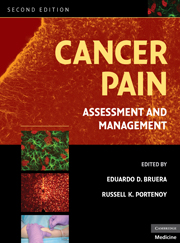Book contents
- Frontmatter
- Contents
- Contributors
- Preface
- SECTION I MECHANISMS AND EPIDEMIOLOGY
- SECTION II EPIDEMIOLOGY AND SYNDROMES
- SECTION III ASSESSMENT
- SECTION IV PHARMACOLOGICAL TREATMENT
- SECTION V OTHER INTERVENTIONAL STRATEGIES
- SECTION VI REHABILITATION AND PSYCHOLOGICAL INTERVENTIONS
- SECTION VII THE ROLE OF ANTINEOPLASTIC THERAPIES IN PAIN CONTROL
- SECTION VIII PAIN IN SPECIAL POPULATIONS
- 22 Cancer pain management in the chemically dependent patient
- 23 Cancer pain in children
- 24 Managing cancer pain in the elderly
- SECTION IX DIFFICULT PAIN PROBLEMS
- SECTION X SYSTEMS OF CARE
- Index
- Plate section
- References
22 - Cancer pain management in the chemically dependent patient
from SECTION VIII - PAIN IN SPECIAL POPULATIONS
Published online by Cambridge University Press: 06 July 2010
- Frontmatter
- Contents
- Contributors
- Preface
- SECTION I MECHANISMS AND EPIDEMIOLOGY
- SECTION II EPIDEMIOLOGY AND SYNDROMES
- SECTION III ASSESSMENT
- SECTION IV PHARMACOLOGICAL TREATMENT
- SECTION V OTHER INTERVENTIONAL STRATEGIES
- SECTION VI REHABILITATION AND PSYCHOLOGICAL INTERVENTIONS
- SECTION VII THE ROLE OF ANTINEOPLASTIC THERAPIES IN PAIN CONTROL
- SECTION VIII PAIN IN SPECIAL POPULATIONS
- 22 Cancer pain management in the chemically dependent patient
- 23 Cancer pain in children
- 24 Managing cancer pain in the elderly
- SECTION IX DIFFICULT PAIN PROBLEMS
- SECTION X SYSTEMS OF CARE
- Index
- Plate section
- References
Summary
Introduction
There is a potential risk for substance use problems in cancer patients managed in the palliative care setting, the severity of which varies significantly across subgroups. The potential for substance use problems in cancer patients may be manifested in various case scenarios: Patients may increase their dosages of prescribed drugs without informing their physicians, or use their analgesics to treat symptoms other than those intended; other patients helpfully present to the palliative care team with a known history of, or current addiction to, illicit drugs or prescription medications. Accordingly, efforts to appropriately identify, assess, and clinically manage substance-related problems are critical to the optimal treatment of cancer patients in the palliative care setting. In this chapter, we discuss these important issues and describe how clinicians can assert control over opioid prescriptions by closely monitoring drug use and by using specific strategies to structure drug therapy. By implementing these strategies and methods, clinicians can help address substance use problems in cancer patients while ensuring that pain and other symptoms are not undertreated.
Prevalence rates of drug abuse and addiction: general U.S. population versus cancer population
In 2006, approximately 50% of people aged 12 and older in the United States reported using illegal drugs at some point in their lives, and between 6% and 15% have a current or past substance use disorder. Further, rates of controlled prescription drug abuse have risen dramatically in the United States, with rates nearly doubling between 1992 and 2003 from 7.8 million to 15.1 million.
- Type
- Chapter
- Information
- Cancer PainAssessment and Management, pp. 423 - 432Publisher: Cambridge University PressPrint publication year: 2009
References
- 1
- Cited by



